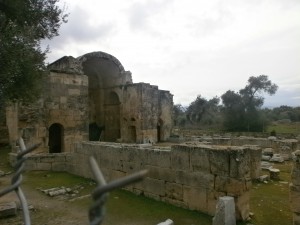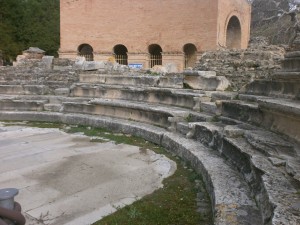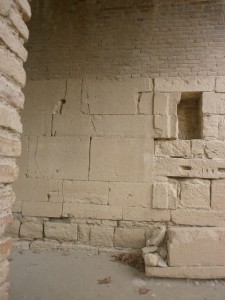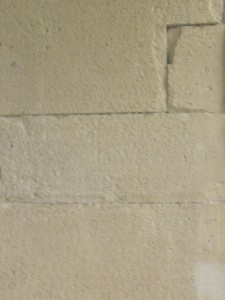Today, we explored the Roman city of Gortyn (or Gortyna), capital of the province of Crete and Cyrene. As the largest Roman city on Crete, it boasted enormous structures including an amphitheater, two theatres, an odeion, and a bath.
When we first entered the site however, the first remarkable landmark was in fact the earlierst church built in Crete. Built in the 6th century CE, the church also used architectural fragments from what believe to be an earlier temple. You could see this by looking at the stones used in the architecture – differing shapes, reused in unusual formations point towards recycling on the Roman architects’ end. This church was built to be a basilica with a cross dome plan and an eastern influence.
The church really was in marvelous condition, but we were unable to go inside due to current excavation/conservation work going on. We watched and discussed the workers on the site, with Bryan and Cashman explaining the specificities in working on archaeological sites in Greece: while the finds and the land of a field site belong to the country, different “international schools” can apply to excavate there – excavating without being part of an international school isn’t allowed.
Moving on from the church, we walked over to the Odeion. The first few rows of stairs were in very good condition and I found myself in awe over the marble floor, still very much intact. Odeions were generally used solely as concert halls, but research on Gortyn’s suggests that it was also used as a political space. We noted as we took in the tall mountains around us (with consistent sheep climbing up the side), that the choice of location was particularly Roman: the Greeks liked to build their amphitheater-like-spaces into hill sides to make use of the natural incline. The Romans on the other hand instead built supporting arches to support the structure and built the seats from the ground up.
At the back of the Odeion was the true prize of today’s sights: the Law Code of Gortyn. Written in the mid 5th century BCE, this public documentation lays out the laws of the city involving different items of personal conflict such as rules of property, marriage, and citizenship. When the Romans built their Odeion, they reused the blocks from this Law Code laying them out in the outer perimeter wall of the building’s structure. Reusing previous blocks was in fact common (as seen in the church although built years later). Elsewhere in the structure, you can see blocks with writing carved in used as part of the walls. They would have formerly been covered in plaster, however, and not been noticeable. With the Law Code, it’s different – emphasized and placed in its own walkway within the Odeion and meant to be observed.
After this, we moved on to look at some Roman sculptures that had been uncovered in the site (including a couple of Herculean Women) before crossing the street to admire the Temple of the Egyptian Gods, the Temple of Pythian Apollo, the Praetorium, and the baths. The final thing we came upon in our venturing was the newer excavations of one of the theatres of Gortyn. It was only half excavated – the other still covered under the current layer of earth. It was built similar to the Odeion in that exterior structures held up the towering seats, but instead of a completely “free” area to work with in the center, there was a stage with areas to utilize beneath and behind the main area. All of these are examples of the Romans modelling Gortyn off of other areas of the empire, showcasing how the splendor of these other areas continued into outer provinces.





